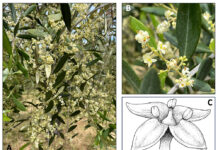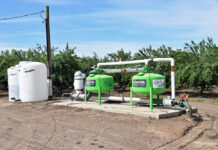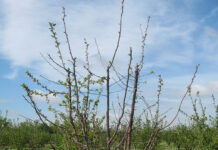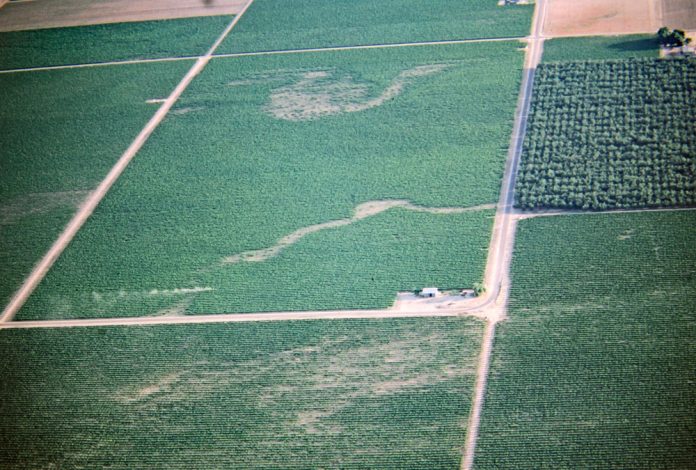
The 2021 season was a challenging year for western grape growers. After an unusually dry, cool winter, many growers observed poor shoot growth and various fruit maladies from bud-break through harvest. Delayed spring growth, vine mealybug and leaf hopper infestations, heat waves and water shortages were just a few of the issues that caused problems for grape growers.
Farmers and viticulturists were busy trying to diagnose various vineyard problems from shortly after bud-break through leaf fall. Diagnosing vineyard problems as soon as possible is important for minimizing yield and quality losses, especially when caused by pests that can be managed before moving into neighboring vineyards. However, when a quick diagnosis cannot be made, it is important to survey the vineyard and collect as much information as possible so damage can be mitigated.
Prompt Data Collection
When trying to diagnose abnormal plant growth, it is important to collect as much data as possible near the time that it was first observed. Data in the form of dates, symptoms (e.g., abnormal growth), signs (e.g., insects), records, etc. are important for you and those you may consult with in determining the cause of poor growth. Table 1 highlights important information to collect for proper diagnosis. The most basic information focused on vineyard characteristics, such as variety/rootstock combination, weather, soil, irrigation type, grape tissue analysis, etc., are typical data needed to solve vineyard problems. Sometimes, it can take days or weeks of consideration to determine what has affected the vines. However, there are times when a problem remains unsolved, even after data have been collected and reviewed by multiple experts.
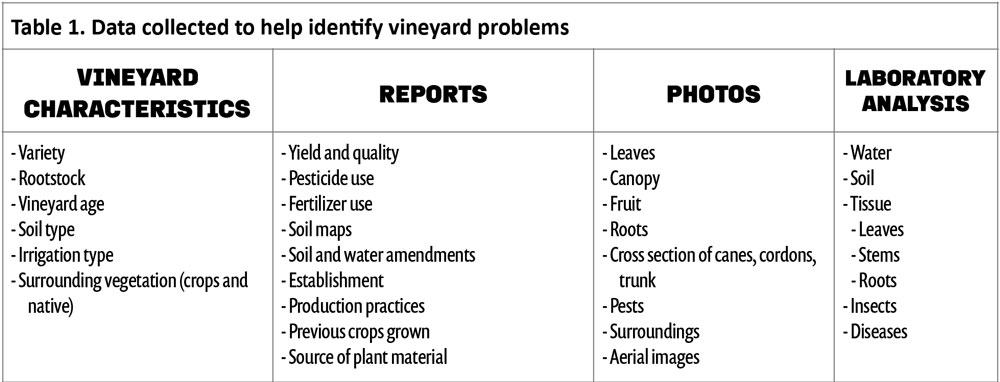
After basic vineyard characteristics, reports (see Table 1) of varying types are important pieces of information for deciphering vineyard issues. Phenological dates, yield and quality, fertilizer and pesticides used, etc. give clues about what has happened this season and in past years that may correlate with a particular issue. The more reports that are available for review, the easier it will make solving the problem.
Photos are a great tool because they can easily and quickly be shared via email or text. Today’s phones are equipped with a camera that can capture both photos and video that make documenting vineyard problems easier. However, there is a difference between a photo and a great photo that can help solve the cause of symptoms. Great photos show detail that can aid in determining the cause of symptoms. For example, a picture of a single leaf on the bed of a truck probably won’t help identify a problem. A more useful photo would highlight multiple symptomatic leaves showing their location on the grapevine and in the vineyard, which may highlight the root cause of a problem.
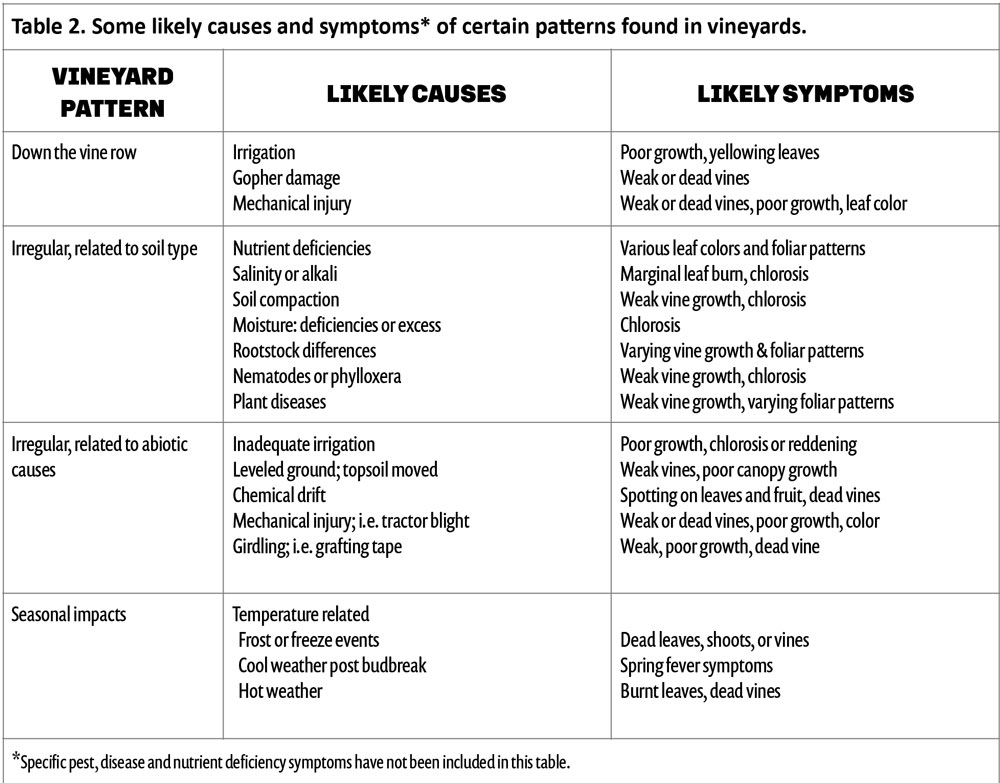
Water, soil and tissue laboratory analysis when taken annually help identify trends over seasons. The best approach is to pull samples at specific times (i.e., growth stages) each year so the information is available when decisions need to be made. For example, taking water samples at the beginning of the growing season will help determine how much nitrogen is coming from irrigation water sources. Once known, planned fertilization rates can be adjusted depending on the amounts in the water. Excess nitrogen applied during the season without knowing what is in well water can contribute to poor fruit quality and may further contaminate the aquifer.
Biotic vs Abiotic
Vineyard issues affecting vine health and fruit production fall into two categories: biotic or abiotic. Issues caused by insects, fungi, bacteria, viruses, rodents, birds and other living organisms are biotic. Abiotic includes non-living factors like climate, soil compaction, water, pH, nutrient presence or lack thereof, etc. Biotic factors tend to be the most common reason for poor grapevine health but aren’t always the primary cause.
Trying to separate symptoms between biotic and abiotic vine health issues can take time to sort through since symptoms can have multiple causes. For example, a vineyard may be showing signs of decline due to root rot infections. However, the real cause may be the presence of hardpan not allowing water to drain. Water accumulating around vine trunks often leads to fungal infection, decline and vine death. Symptoms from both fungal infections and poor water penetration can have similar symptoms (weak vine growth with chlorotic foliage). Identifying the primary cause is important so a solution can be developed and implemented.
Understanding Patterns
Patterns of symptomatic vines are an important piece of information needed to solve the cause of poor vineyard growth. An easy way to identify patterns is the use of aerial imagery (Figure 1) to survey your vineyard. Aerial imagery has improved tremendously and can help detect differences in vine growth, soil and irrigation issues, pest or disease problems and more. Accessing aerial imagery is as easy as using your own drone to capture footage or hiring a licensed pilot or company to take photos and video for you.
Data from aerial imagery can also be transformed into helpful indices such as NDVI, and specialized sensors such as thermal or hyperspectral images provide additional data for assessing vineyard condition. Aerial imagery can help you track irrigation problems or general vine health throughout the season by outlining patterns based on vine growth and leaf condition.
Driving and walking vine rows with a soil map in-hand can be essential for assessing problem areas. Surveying the vineyard on foot or with an ATV allows for a closer look at low-vigor areas, which may give you management clues that can complement aerial imagery. Patterns of poor growth found on vineyard edges, down rows or in small patches are sometimes easily solved when those areas are visited on foot. For example, Figure 2 shows multiple vines within a row that are weak or dead. At first glance, a disease might be suggested as the cause of poor growth and death. But after further investigation from top to bottom, it was found that the base of the vine and root system had been chewed and girdled by meadow voles. Once the problem was identified, a management plan was implemented, which ended additional vine deaths.
Symptom Diagnosis
Diagnosing abnormal growth symptoms is somewhat of an art and a science. When called to identify the cause of poor or unusual growth, a vineyard diagnostician must consider all the scenarios that might be causing symptoms.
A methodical approach that results in an accurate diagnosis is important since time is of the essence when considering management strategies to minimize yield and quality losses. Variety, rootstock, vineyard age, soil type(s) and depths, irrigation methods and timings, nutrition, common pests, diseases, climate and many other factors must be considered. A systematic approach must be taken to identify the primary cause that includes symptoms found in the vineyard, including related reports, photos and laboratory analyses.
Diagnosing grape pests or diseases can be easier than abiotic causes since three factors need to be present: the pest or disease, grape (i.e., host) and favorable environmental conditions.
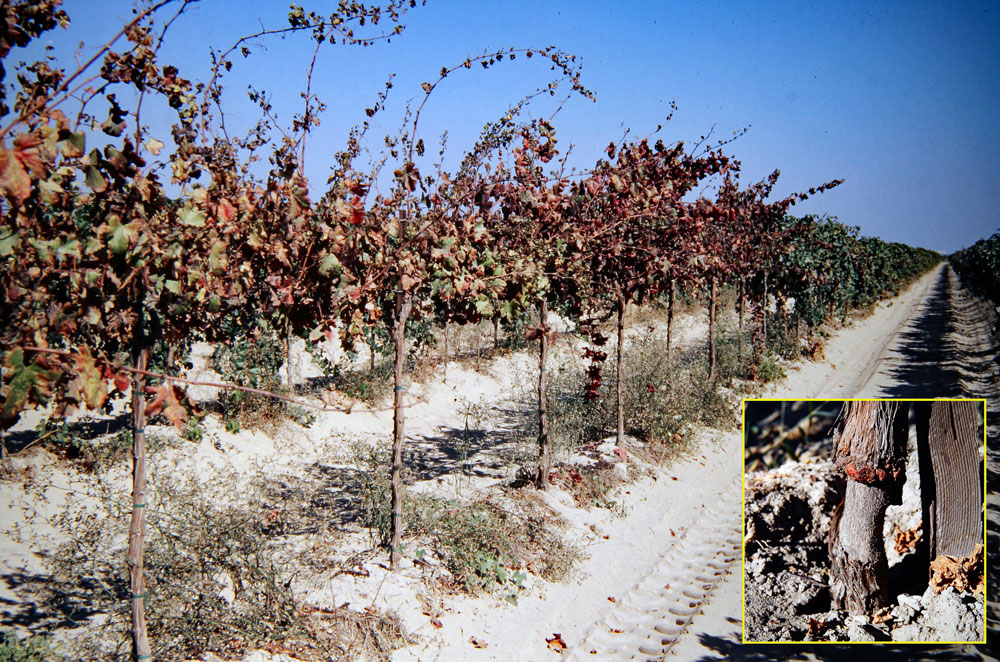
Often, the lack of optimal climatic conditions do not allow for pest or disease outbreaks. In contrast, the cause of abiotic symptoms is more difficult to identify and costs time and resources. Once pests or diseases have been eliminated as causes, a diagnostician must spend time reviewing reports, lab analysis and walking the vineyard looking for patterns and additional clues. A shovel, shears, soil probe, and a lot of time will be needed to narrow down the cause.
Finding a Trusted Advisor
Solving vineyard problems that are negatively impacting yield and quality can be daunting, especially when you are working alone. At some point, you may need to consult with an expert. Finding a trusted advisor can also be daunting because there’s often a cost associated with hiring someone. Here are some considerations for finding and hiring a CCA, PCA, private consultant or agricultural forensic consultant.
Before hiring someone, clear goals need to be identified so they can be shared with a prospective consultant. First, what are the yield and quality goals for the vineyard and are they being impacted by the problem? Are you trying to determine what has reduced vineyard performance or what has killed vines? Second, do you want solutions to end the loss of vines and stop the yield decline? Finally, do they have the experience needed to help you solve your vineyard problem? Are they focused on your success or are they just interested in selling you something that will “correct” the problem? If it is a challenging problem, do you feel confident that they will tell you the truth if they don’t know what the cause of poor growth is in your vineyard? If you don’t already have a trusted CCA or PCA, it may take some time to interview a consultant that you feel confident will help you and have your success in mind.


